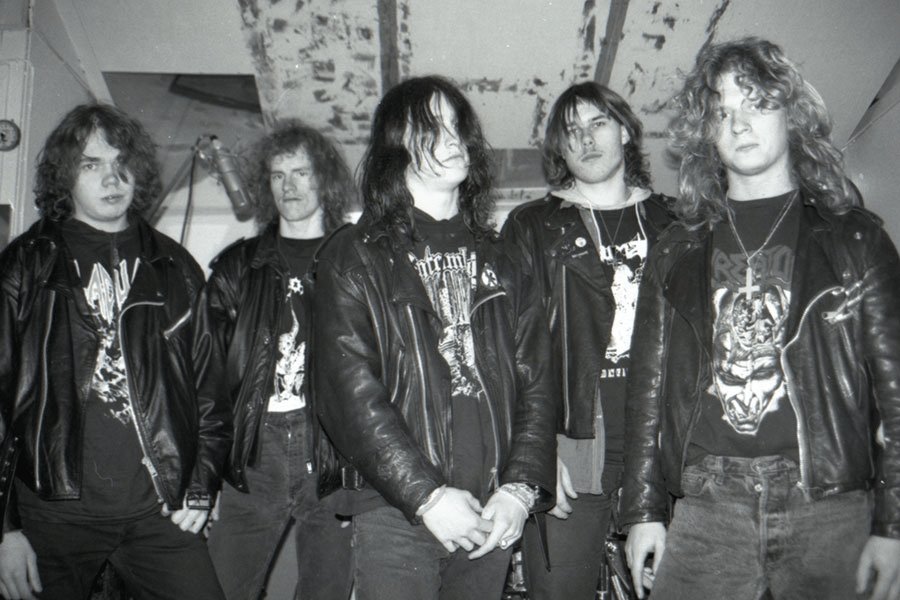Edge of Sanity – “Crimson” (1996, Black Mark Production)
In the vast tapestry of 1990s extreme metal, “Crimson” by Edge of Sanity stands as a true anomaly, equal parts death metal epic, progressive rock opera, and dystopian myth. Released in 1996, at the midpoint of Dan Swanö's creative explosion, “Crimson” is both a culmination and an outlier: a single 40-minute song, fully realized, fully narrative, and fully committed to its world. It remains one of the most ambitious works in death metal history, and nearly three decades later, it continues to resonate as a blueprint for how heavy music can evolve without losing its teeth.
A Story Worth Screaming About
At the heart of “Crimson” lies a high-concept science-fantasy dystopia, told in fragmented yet evocative verses. The tale unfolds in a post-apocalyptic future where humanity can no longer reproduce. A child is miraculously born to the king and queen, but their hopes of salvation are quickly dashed. The girl, known as the “Crimson” Queen, eventually ascends to power, but is corrupted by it, ushering in tyranny instead of redemption. Rebellion, tragedy, and cosmic despair follow. The ending is as bleak as it is poetic.
This narrative would be compelling in its own right as a novella. That it is told entirely through music—growls, clean vocals, harmonized leads, shifting dynamics, is a testament to the album’s towering ambition. There’s something medieval, almost biblical, about the tale, but it’s filtered through a sci-fi lens: Children of Men meets Game of Thrones, via Morbid Angel and Pink Floyd.
Structure as a Statement
“Crimson” is structured like a symphonic movement, rather than a traditional metal album. There are recurring motifs, thematic reprises, dynamic peaks and valleys, and a real sense of progression. Instead of the typical “riff-breakdown-chorus” structure, “Crimson” unfolds like a river, sometimes violent, sometimes reflective, always moving forward.
Musically, this approach was unprecedented in death metal at the time. While progressive rock bands like Yes or Genesis had long flirted with side-long tracks, and black metal artists like Bathory or Burzum were stretching song lengths for atmosphere, Edge of Sanity did something different: they merged narrative cohesion with musical brutality, and the result was uniquely compelling.
Each section of “Crimson” feels distinct yet connected. There’s melodic death metal riffing with that unmistakable Swedish bite, doom-laden passages that simmer with despair, clean vocal interludes that break the tension, and progressive sequences that twist and evolve. And yet, despite its complexity, “Crimson” never loses focus.
Dan Swanö: Architect of the Abyss
Dan Swanö, multi-instrumentalist, producer, vocalist, and mastermind, is the reason “Crimson” works. His fingerprints are everywhere: from the guttural roars that drive the heavier passages, to the melancholic clean vocals that evoke a sense of tragic grandeur. His guitar work is fluid and expressive, seamlessly blending melody with menace. And his sense of composition is what elevates this record into the realm of ART.
Swanö’s role as both performer and producer is crucial. The production on “Crimson” is crisp yet raw. The drums have punch, the guitars bite, and the vocals sit perfectly in the mix. Importantly, the transitions, so crucial in a one-song album, are smooth and musical, never jarring. The album ebbs and flows with a natural rhythm, and that’s no small feat.
Repetition, Motif, and Memory
What makes “Crimson” even more impressive is how it uses repetition and motif to anchor the listener. Riffs return in altered forms; vocal lines echo earlier phrases; guitar harmonies that appeared in a moment of triumph reemerge in defeat. These musical callbacks act like narrative bookmarks, giving the story a cyclical, mythic feel. There’s a particular guitar melody that appears around the halfway point, then again near the end, slower, sadder, more broken. It’s a masterclass in emotional storytelling through composition, allowing the listener to feel the arc of the story without needing to parse every lyric.
Death Metal as Tragedy
“Crimson” is ultimately a tragedy, of power, loss, and existential futility. The birth of the “Crimson” Queen, initially framed as salvation, becomes the catalyst for destruction. The rebellion that rises to overthrow her becomes just another cycle of pain. By the time the track closes, there is no resolution, only repetition, a return to the beginning, like a wheel turning endlessly.
This kind of storytelling is rare in metal, especially in death metal, which often favors impressionism or abstraction over narrative clarity. “Crimson” stands almost alone in its literary ambition. It’s the Oresteia in blast beats. It’s Paradise Lost filtered through Swedish distortion.
Legacy and Influence
In hindsight, “Crimson” was ahead of its time. Long-form, single-track albums have become more accepted in extreme metal circles, bands like Insomnium (“Winter’s Gate”), Bell Witch (“Mirror Reaper”), or even Ne Obliviscaris, owe a debt to Edge of Sanity’s audacity.
That said, no one has quite replicated the balance of death metal weight, progressive elegance, and narrative cohesion that “Crimson” achieved. Its follow-up, “Crimson” II (2003), expanded on the story but never quite captured the same lightning-in-a-bottle magic. Today, “Crimson” is a cult classic, revered by musicians, loved by fans, and studied by those who want to understand how far metal can stretch without breaking. It remains a monument to what happens when creativity meets courage, and when a band dares to dream on a massive scale.
“Crimson”
is not just a record. It’s a journey, a sonic saga told with fire and feeling.
It blends the philosophical with the brutal, the operatic with the raw. It is
one of the few albums that feels as massive as its ambition, and it earns every
second of its 40-minute runtime. For those who like their death metal with
brains, heart, and scope, this isn’t just essential listening. It’s holy text.


Comentários
Enviar um comentário